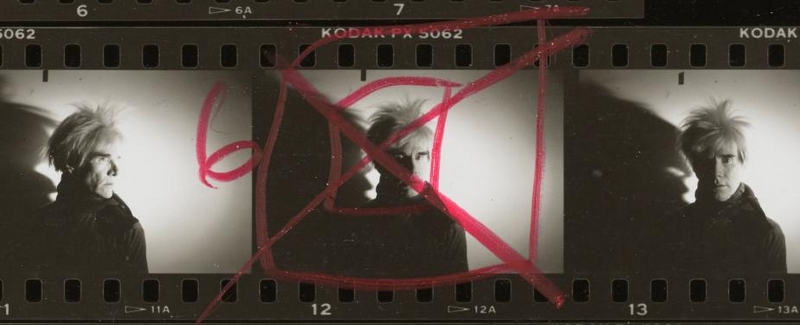
Andy Warhol (U.S.A., 1928– 1987), Detail from Contact Sheet [Photo shoot with Andy Warhol with shadow], 1986. Gelatin silver print. Gift of The Andy Warhol Foundation for the Visual Arts, Inc., 2014.43.2893. ©The Andy Warhol Foundation for the Visual Arts
Tens of thousands of unpublished pictures taken by Andy Warhol of celebrity friends such as Liza Minnelli, Bianca Jagger and Debbie Harry are to be made public for the first time in what is described as an unparalleled collection of his photography.
More than 130,000 individual frames have been made available by the Andy Warhol Foundation for a forthcoming book, exhibition and the digitisation for the general public of every single image – most of which have not been seen before. Markings on 3,600 contact sheets show that Warhol printed only 17% of his photographs.
Spanning 11 years leading up to the artist’s death in 1987, the images open doors to both his dazzling social circle and his private world. In one photo, the writer Truman Capote is shown stretching out on a couch. In a series of hundreds of pictures capturing an unfolding romance, Jon Gould, Warhol’s last boyfriend, is shown on the beach, in the snow and on a boat.
The Contact Warhol project to make the photographs available for public viewing is headed by Peggy Phelan and Richard Meyer, arts professors at Stanford University, California, which acquired the archive from the Warhol Foundation.

Meyer recalled that he was initially “overwhelmed” by the scale of material, which has “never before been displayed to the public or published, indeed never before [been] available even to researchers”.
Since the contact sheets were made by “arguably the greatest 20th-century American artist, they are valuable additions to the field of art history”, he said. “It is Warhol as you’ve never seen him before. You’re seeing his daily life in a way that’s just never been possible before because these contact sheets have never been available to public view.”
Phelan described the images as “a visual diary”. “The contact sheets not only offer new and important insights about Warhol’s life and work, they also help clarify issues surrounding what motivated and preoccupied him during the last decade of his life.”
Warhol – immediately identifiable thanks to his blond wig – was a pop art founder whose paintings and prints of movie stars, soup cans and soap-pad boxes turned him into one of the world’s most famous artists. Long before reality television, he predicted a future in which everyone would be famous for 15 minutes. His celebrated 1963 work Silver Car Crash (Double Disaster) sold in 2013 for $105m.
He was an obsessive photographer, snapping whatever caught his eye, from glamorous parties with Hollywood stars such as Bette Davis to seemingly unprepossessing subjects including piles of discarded dishes at a flea market or scratched city signage. “A picture means I know where I was every minute,” he once said. “That’s why I take pictures.”
The photographs will feature in a major exhibition that will run from 29 September to 6 January 2019 at Stanford University’s Cantor Arts Center. The accompanying book will be published in the UK in November, and the digital imagery will be launched online later this year.
Visitors to the exhibition will be warned of “sexually explicit images that may not be appropriate for young viewers”. Some of them feature Victor Hugo, a Venezuelan window dresser and one of Warhol’s close friends, having sex with different men. Little is left to the imagination. They were shot as potential source material for Warhol’s little-known series of silkscreen paintings called Sex Parts, featuring close-cropped views of the human body. Hugo, who died in 1993, is also seen sniffing cocaine.
Phelan said that the decision had been taken to crop the explicit images to protect identities, in an approach influenced by the MeToo movement against sexual harassment and assault. “For me, it was very difficult to look ethically at printing images that haven’t been seen and that were taken in some cases 35 years ago. In the end, I decided not to show the faces of any of these men.”
The most frequent subject is Gould, a Paramount movie executive who died as a result of Aids in 1986, a year before Warhol’s unexpected death after gallbladder surgery. A tall and imposing man, Gould was 26 years younger than Warhol.

The contact sheets reflect the intensity of Warhol’s infatuation with him. One of the book’s essays suggests that Gould had become an idealised, Christ-like figure for the artist. Phelan said: “There are these amazing photos of Gould draped on a clothes line… Warhol had a huge crush on him, although Gould asked Warhol not to be public about their relationship … There are gorgeous photos of Gould … who had a heartbreaking death … So it’s very poignant.”
In another of the book’s essays, Phelan and Meyer write: “While he often asserted that his art could be made by anyone, the contact sheets make clear the depth and range of Warhol’s artistic power.”
guardian.co.uk © Guardian News & Media Limited 2010
Published via the Guardian News Feed plugin for WordPress.

